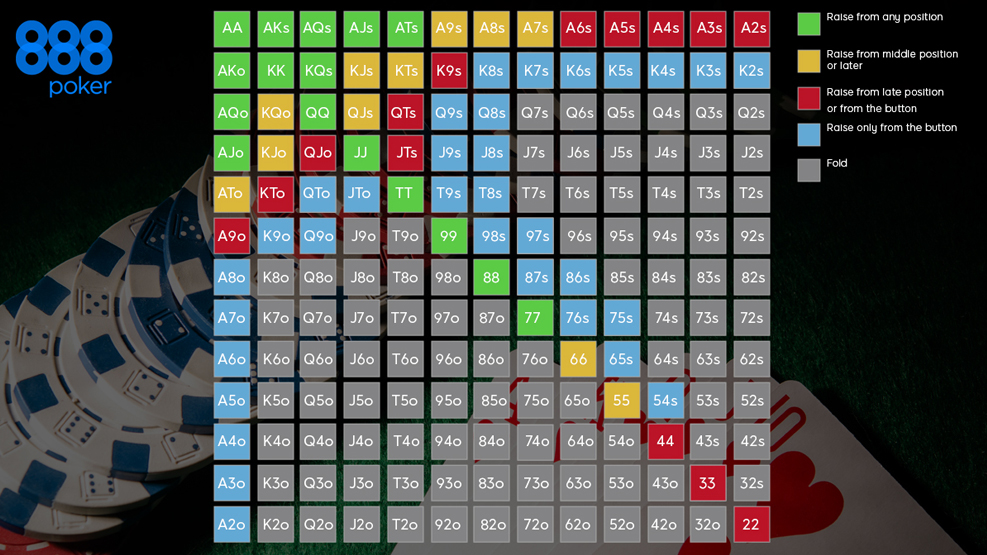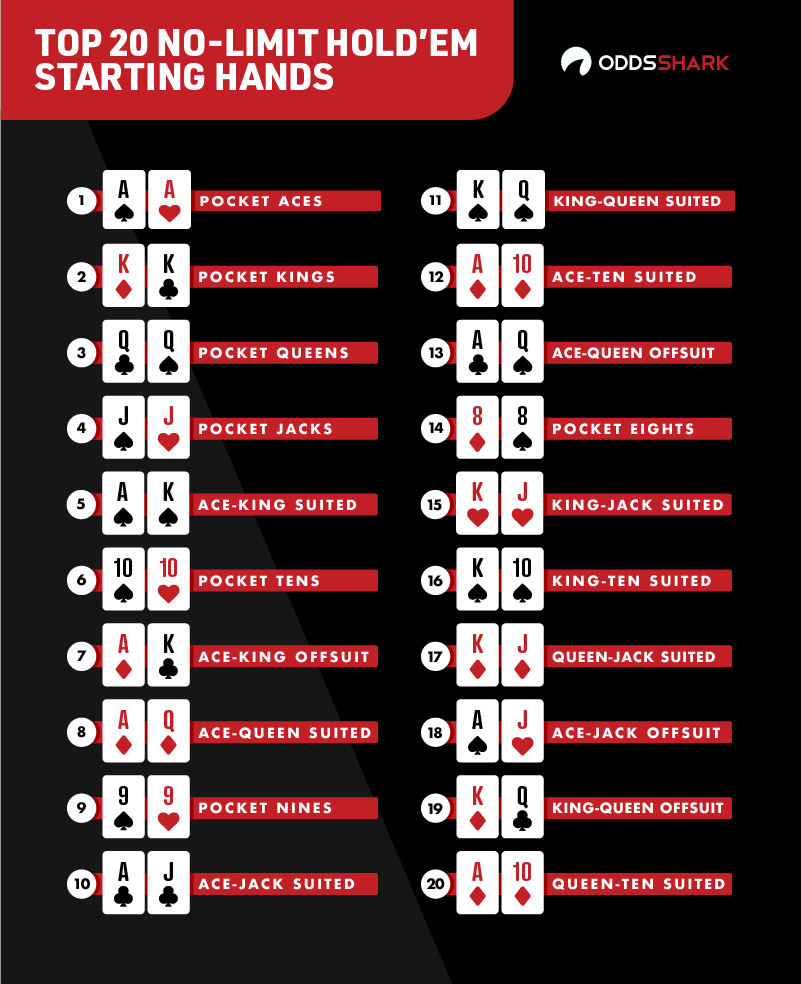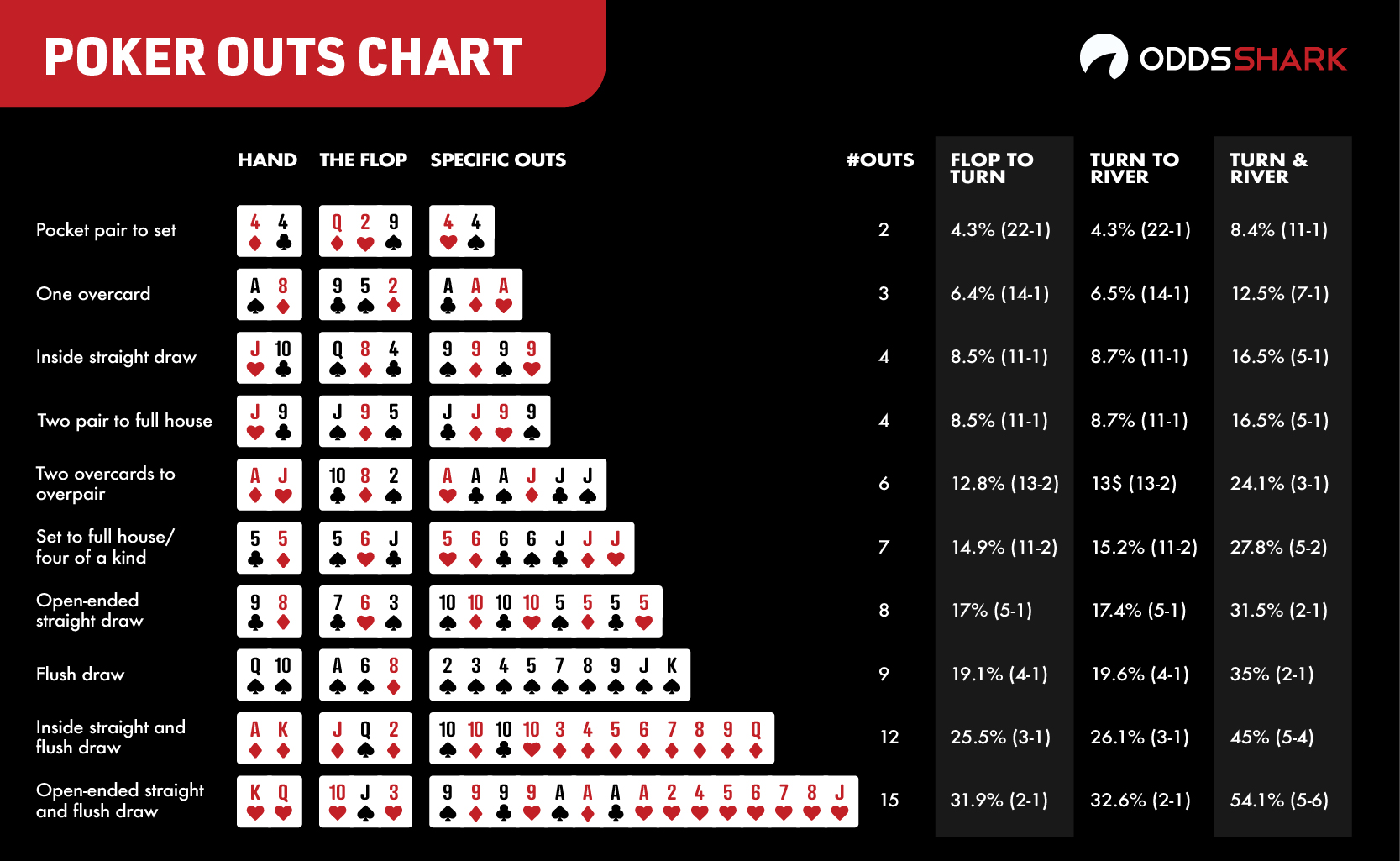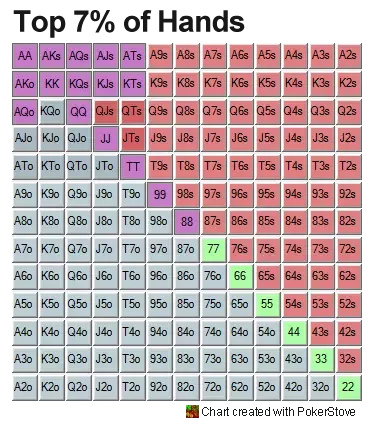Opening Texas Holdem Hands
Download the full resolution Texas Holdem cheat sheet for later use! The progression of Texas Holdem hands. It is effortless to play Texas Holdem when you understand the hand's progression and other basic rules. Therefore, this poker cheat sheet will show you all the actions in order when playing a hand. In poker, players form sets of five playing cards, called hands, according to the rules of the game. Each hand has a rank, which is compared against the ranks of other hands participating in the showdown to decide who wins the pot. In high games, like Texas hold 'em and seven-card stud, the highest-ranking hands win.
The first step to determine the winning Texas Holdem hand is to memorize the official poker hand rankings: Poker Hand Rankings; Once you know that a flush beats a straight and three of a kind beats two pair, you're off to a good start. After memorizing the proper order of poker hands, you'll need to practice reading the board. Top 10 Best Starting Hands In Texas Hold'em Poker. 3 Pocket Queens. 4 Ace-King Suited. 7 Ace-Queen Suited. 8 Ace-King Offsuit.
NL Hold’em Starting Hand Charts
One aspect of the game of No-Limit Hold’em that causes beginning players much grief is deciding which hands to play and which hands to dump. NL Hold’em is much more difficult than Limit Hold’em because the value of a hand depends on so many factors other than just the cards in your hand. Despite this difficulty, our coaches believe that following some general guidelines and adjusting from these is a better solution than having no guidelines at all. Given that well over half of your profitability in NL Hold’em is based on hand selection alone, we have developed these charts to help you better determine whether to play or fold.
There are no perfect No-Limit starting hand charts. That is because there are many factors that affect your decision, and charts cannot account for all of them. Some of these include:
- The size of your opponent's stacks.
- How loose or tight, passive or aggressive, your opponents are.
- Where these opponents are located at the table – for example, does an aggressive player still have to act after you?
- Your image at the table – for example, how tight or tricky you are perceived.
That being said, these charts will serve you well in most typical low-stakes No-Limit cash games, such as games with blinds of $1/$2, and home games. These games typically have several loose players at the table, and good opportunities for winning big pots with suited connectors and pocket pairs. With practice, you will be able to be a consistently winning player with these charts as a starting point. As you improve, you'll find yourself making adjustments to these charts based on the factors listed above, and more.
AGAIN: These charts are a good starting point for beginners. Specifically, Chart #1 recommends a significant amount of limping. This is great in loose, passive games but less often seen in tougher games. You’ll find other training material on Advanced Poker Training that may recommend a more aggressive approach for more experienced players.
Note: It would be a serious mistake to apply these hand charts before reading the Frequent Asked Questions first.
Opening Texas Hold'em Hands

CHART #1 ‐ LOOSE, PASSIVE GAME (OFTEN 4-5 LIMPERS PER HAND)
NO ONE HAS RAISED YET
- Raise Always
- Call from Early Position, otherwise raise
- Call always
- Call from Middle or Late Position if the conditions are right (see Frequently Asked Questions)
CHART #2 ‐ TIGHTER GAME (FEWER LIMPERS) OR MORE AGGRESSIVE GAME
NO ONE HAS RAISED YET
- Raise Always
- Call from Early Position, otherwise raise
- Call (or Raise) from Middle or Late Position if the conditions are right (see Frequently Asked Questions)
CHART #3 ‐ THERE HAS BEEN A SINGLE RAISE
(3‐5 TIMES THE BIG BLIND) BEFORE YOU
- Re‐Raise Always
- Call from Early Position, otherwise re‐raise
- Call always
- Call from Middle or Late Position if the conditions are right (see Frequently Asked Questions)

FREQUENTLY ASKED QUESTIONS
For the hands in yellow, what do you mean when you say to play these hands if the conditions are right? The hands in yellow are speculative hands. They should always be folded from Early Position. From other positions, they can be profitable given the right conditions. Some of the questions to ask yourself:
- Are there other players who have called so far (the more, the better)?
- Are the players who have called playing poorly after the flop? Will they pay me off if I hit something?
- Is there an aggressive player still to act behind me (you might get raised and have to fold)?
- If there has been a raise and no other callers, what chance do I have of using my position after the flop to win the hand even if I don't improve (Chart #3 only)?
Why does Chart #2 say to sometimes raise with the hands in yellow, but Chart #1 does not? We have different goals in mind. Using Chart #1, we want to call to encourage additional players to enter the pot. These hands will be immensely profitable when our loose, passive opponents enter the hand, and get trapped when we flop a set, or make a well-disguised straight. When using Chart #2, however, we want to size up the opponents still to act. If they are tight, we can raise. Sometimes, we'll pick up the blinds. Other times, our pre-flop aggression will allow us to take down the pot on the flop.
What's the difference between AKs and AKo? AKs means an Ace and King of the same suit. AKo means an Ace and King of different suits.
What are early, middle, and late position? Early Position is generally the first 2 (in a nine player game) or 3 (in a ten player game) positions after the blinds. Late Position is the “cutoff” position (to the right of the dealer), and dealer button positions. Middle Position is everything in between.

How much should I raise? As a general rule, raise 3 to 4 times the big blind, plus 1 extra big blind for every player who has called before you. So if there are 2 callers already, raise between 5 and 6 times the big blind.

What if someone raises after I call? Whether you call the raise depends on how much money the raiser has for you to win, how many other players are involved, and what type of hand you have. As a general rule, if you have a pocket pair, lean towards calling. If there are a lot of other players (and therefore a big pot), lean towards calling. In general, fold suited connectors from early position. Fold hands like KQ that don't play well against a raiser.
How do I play from the blinds? From the small blind, play the same hands you would play from late position, plus a few more. But don't call with junk hands like T5o, just because it is “cheap”. From the big blind, if there is a raise to you, play like you would if you had already called from early position.
The chart says to fold KQo to a raise. Really? Yes, this hand performs very poorly against typical raising hands. Against AK, AQ, AA, KK, QQ, you are a big underdog. Other typical raising hands like JJ, TT, 99, AJs, are slightly ahead of you as well. The only time you might call or re-raise is from late position, if the opener was in middle or late position, indicating they might have a wider range of hands.
I was told to fold AJo from Early Position, why do you say to call with it? Folding AJo is not a bad idea in many games. We included it because, at low stakes tables (even tight or aggressive ones), the players are often playing badly enough after the flop that it can be profitable. We used data from millions of hands of low-limit poker to analyze this. The same could be said for KQo, ATs, and KJs – you can make a small profit in the long run at most low-stakes games, but folding would be perfectly acceptable from early position.
Can I use these charts in a NL Hold'em tournament? The charts would be best applicable to the early stages of a NL tournament, when everyone has a deep stack. In the middle and later stages, they should not be used.
Read all our instructional articles
So by now we all know which starting handsare good and which are bad, but there's still a ton of variables that should influence your decision to open a particular hand preflop....In this article we'll look at some important factors when deciding pre-flop opens:
i) Limitations of the Starting hand chart
ii) Position
iii) Limpers/Posters
iv) Stack-sizes
v) Open-raise size
Texas Holdem Opening Hands Chart
vi) Edge/Reads
Limitations of the starting hand chart
Don't take the starting hand chart as gospel!
Many beginners are encouraged to make use of a starting hands chart (SHC)when first embarking on a poker career. While this suggestion is not without merit, it is particularly important to understand where its limitations lie.
A starting hands chart is very useful as a rough guide for an absolute beginner, but your ultimate goal should be to progress away from this as soon as possible. Poker is a dynamic game; the person who can adjust the most efficiently to the strategy of another is the one who will win the chips in the long run. Playing a static strategy in such a game is going to, at the very least, confine you to mediocrity - if not cause you to become a downright losing player.
Assuming we had a SHC representative of tight-aggressive play, let's consider some of the situations where we would typically deviate from our 'standard' open-raising strategy in a 6max game.
Position
Opening Hands Texas Holdem
This is partially factored into most starting-hands charts. A hand like A8o should be a standard open-raise on the button in many games. A8o from UTG however, is usually going to be trash and is a standard fold.
You should also consider your position relative to other players at the table. If there are fish in the blinds you might choose to open looser from early-position, because if these players call you will have position postflop. If there are loose or aggressive players in position on you, you should often tighten up. Perhaps you are in the CO with a loose-aggressive player on the button, and as a result you should tighten up your CO opening-range.
Limpers/Posters
If there are fish who open-limp you can choose to iso-raise a lot wider when you have position. (This is not strictly an 'open'-raise but similar principles apply.) Perhaps you find yourself with a hand you wouldn't normally open raise with from a specific situation, but playing that hand in position against a fish will likely still be +EV.
Texas Holdem Best Opening Hands
A similar principle applies if there are posters involved in a hand. You can often raise a little wider seeing as the extra dead-money means you don't need to steal the pot as often for it to be profitable. Posters will be folding a lot because their range pretty much includes any 2 cards. If you've already seen them check, their range becomes any 2 cards they didn't want to raise!
Stack Sizes
This is one factor that is completely disregarded in almost all SHCs, yet is a crucial piece of information in establishing which ranges you want to open.
If we take a very simplified view of the different starting hands we can split them into two categories. Hands which benefit from implied-odds, and hands which suffer from reverse implied-odds.
Hands which benefit from implied-odds: These typically include speculative hands like 78s. These hands don't have immediate showdown-value, yet they do have some potential to make strong nutted hands a small proportion of the time. It's important that when you do make a flush/straight/straight-flush that there is enough money in villain's stack to make it profitable in the long run. In other words, if villain has a very short stack, it can quite easily become un-profitable to play a hand like 78s.
The other type of hand, is that which suffers from reverse implied-odds: These are hands with immediate showdown value like AK, or QQ. You have no problem playing these against a shortstack because a large proportion of the time you will either be committed preflop or on the flop. They suffer from reverse implied odds because as the stacks get deeper, you are less happy with stacking off with the type of hands they make, namely big one-pair hands. If your opponent seems extremely happy to get 200BB stacks in, it's likely that your AK on the K678 is no good; whereas, if villain only has a 25BB stack, it's a snap-call with TPTK.
The hands in between:
There are some hands that fall in the middle of these two categories, such as QTs. This is both a speculative hand, and a hand that makes weak-top pairs. How you choose to play it depends on the exact circumstances. Much of the time if villain is deep, you will play it as a speculative hand, while if villain is shallow you will play it as a TPGK hand.
General rule of thumb:
As a general rule you want to tighten up your open-raises when shortstacks are still left to act. As the stacks get deeper you can start opening a lot wider with all kinds of speculative hands. (Theoretically when the stacks are super-deep, perhaps 1000bb deep, you can open 27o even if you never steal preflop, because you have sufficient implied odds. In practice you'd only ever do this if you expect to have a huge post-flop edge). You should then be careful playing TPTK/Overpair as the stacks get deeper. Playing AKo 200BB deep, it is likely you will need to employ some pot-control during the hand if you make a TPTK hand. You will also be less comfortable putting yourself in a situation where you need to stack off preflop for 200BB+, even with hands like KK where it might be standard to stack off in a 100BB pot.
Open-Raise Sizing
You should often vary your open-raise size, depending on the players at the table and the position you are opening from.
Typically many follow a strategy where they open larger from UTG, and smaller from the Button. This is partially because your UTG open-raising range is typically stronger than your BU opening range. Your UTG open also needs to get through more players, and you perhaps discourage them from calling you in-position with a slightly larger open raise size.
This is just a generic sizing strategy however, and you should consider making deviations depending on the players at the table. Perhaps you are getting relentlessly 3bet by a certain opponent; you could choose to open-raise smaller so you lose less, make 3betting less attractive for villain, and also make it easier for you to flat-call if you were so inclined.
Or perhaps villain is a huge fish, that plays every hand, but always check-folds when he misses the flop. Why not open-raise large, perhaps 5x or 6x and take it down on the flop? Perhaps villain NEVER folds anything preflop, and you have AA, why not raise to 10x or even more?
Conversely perhaps you are UTG with a suited-connector, and you know that regardless of your raise sizing, you are likely getting called in several spots. So why not open-raise smaller?
I am ready to take my poker game to the next level!
Best Opening Texas Hold'em Hands
Edge/Reads
A big factor in which ranges you choose to open also depends on any reads you have and also how big your edge is.
It's often going to be wise to discard any marginal opens if the table is very tough. Certain hands like Axs which you can potentially open UTG in some games, perhaps become standard folds in games where you are going to exploited too heavily by smart opponents with position.
Certain reads may cause you to open tighter/loser, or may also cause you to open slightly different ranges. If you know villain is a postflop calling station, you might want to tighten up your open-ranges. If you know villain will play fit-or-fold on every flop, you can sometimes loosen up quite dramatically.
Perhaps you know villain is 3betting very wide, and then open a certain type of hand with the intention of 4bet-bluffing because it contains certain blockers. The further you can plan a hand before you've even open-raised, the more specific you can be about which ranges you want to open.

Summary
While SHC's may be useful tools from a theoretical perspective, and for the use of beginners, there are many aspects of a real poker game that are simply not taken into account, such as stack-sizes and relative position.
In general, the deeper the stack-sizes, the less useful a SHC becomes. A SHC certainly carries a little more relevance when applied to short-stacked play, purely because it is a little easier to say how close a play is to the mathematical optimum, but there are still deviations that could be made depending on who is at the table amongst other factors.